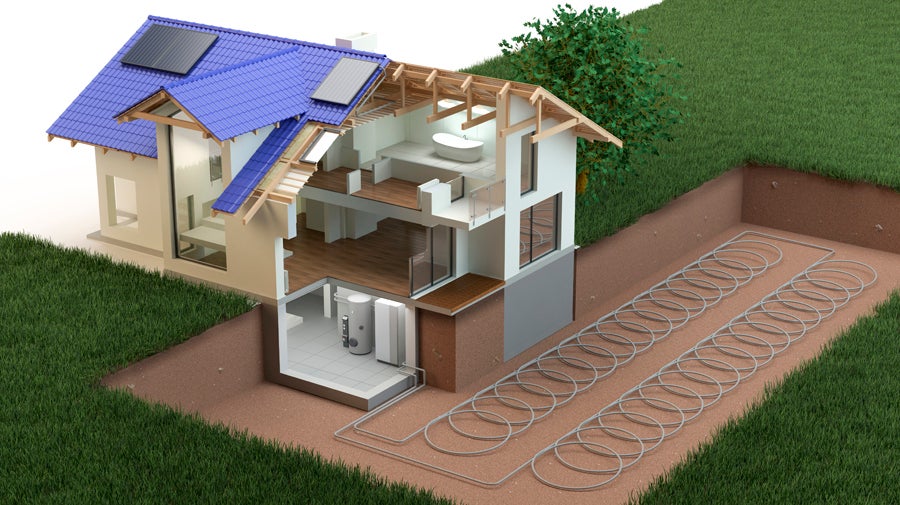Another major form of centralized split-system is the heat pump. These systems work like air conditioners during the summer and reverse to become air heaters during the winter. Care needs to be used in installing air-source heat pumps in cold climates as the primary heating system as they rely on temperature differentials between the refrigerant and air to perform their heating and cooling functions. For cold climates, other types such as ground-source, are a better choice.
During the summer cooling made, refrigerant is piped through the indoor coils, absorbing heat from the indoor air, and vaporizes. As the cooled air is supplied to the home, the vaporized refrigerant flows into the compressor, which pumps the refrigerant to the outdoor coil where it condenses back into a liquid by releasing its heat to the outdoor air. The cooled refrigerant then flows back to the the indoor coil, where the heat transfer cycle is repeated.
In the heating mode, the refrigerant flow is reversed, bringing heat inside from outdoors, essentially working like a conventional air conditioner in reverse. The cold refrigerant is piped through the outdoor coils, absorbing heat from the outside air. The refrigerant vaporizes and flows into the compressor, which pumps it to the indoor coil, where it condenses back into a liquid by releasing its refrigerant then flows back to the outdoor coils, where the heat transfer cycle starts again.
Like refrigerators, most heat pumps have defrost cycles that minimize frost buildup on the evaporator during the winter heating cycle. Defrost occurs automatically at pre-set time intervals. Defrosting works against the efficiency of the unit when it switches into the defrost made unnecessarily, wasting heating and cooling capacity. Microprocessor controls in some units prevent this from happening.
Building codes may require that heat pumps have back-up heating systems for protection of the homeowners during extreme cold periods. These back-up systems can be resistance electric heat or a fossil fuel. When looking at a heat pump, look for models with controls that optimize when to use which heating source. These controls focus on economics rather then which is most efficient.
ELECTRIC AIR SOURCE
Electric air source heat pumps are basically reversible air conditioners. They are referred to as air source because they move heat from the air in one location to the air in another. In some parts of the country (especially in mild climates) they are the least expensive way to heat and cool a home.
Since heat pumps move air rather than generate heat, they can be extremely-efficient, delivering more than three times as much heat as they consume in energy. This efficiency is expressed as a COP or Coefficient of Performance. When looking for a heat pump, look for a COP of at least 3.0. For comparison purposes, simple resistance electric heat has a COP of 1.0.
Heat pumps have an additional advantage of providing heating and cooling in one unit using a single energy source. Also, heat pumps do not require flues or their associated roof penetrations.
ADD-ON HEAT PUMP
Heat pump systems can be combined with natural gas, propane, or oil-fired heating systems. These are known as add-on, dual-fuel or hybrid heat pumps. During the heating season, when the outdoor temperatures drop below the thermal (or economic) balance point of the heat pump, the heat pump turns off and the gas or oil furnace comes on to provide heating. In other words, the electric resistance auxiliary heat found in conventional air-to-air heat pump system is replaced by the gas or oil furnace.
The add-on heat pump unit is popular for installation on older homes with central systems that were not previously air conditioned, or for homes whose cooling system needs replacing and the furnace is still in good shape. Besides providing air conditioning, add-on heat pumps increase the overall efficiency of the heating system because both the heat pump and the fossil furnaces are operating at their optimal efficiency levels.
For new construction, this heat pump system may also be more cost effective than an all-electric heat pump, particularly in colder climates.
GEOTHERMAL HEAT PUMP
Geothermal heat pumps operate like air-to-air heat pumps using the ground or water as a heat source and heat sink, rather than outside air. Because the ground or water temperatures are much more constant year-round (warmer in winter and cooler in summer) geothermal heat pumps operate more efficiently than air-to-air heat pumps. They are also more effective in colder climates in the heating mode.
Geothermal heat pumps are becoming more popular due to their heating and cooling energy efficiency and related environmental and ownership benefits, especially where ground water is available or soil conditions are favorable. In the heating mode, a geothermal heat pump typically extracts two-thirds (or more) of the needed energy from the earth or water loop and moves it indoors. Only one-third of the energy is purchased power, primarily used to run the compressor. In the summer, geothermal heat pumps move heat from indoors into the relatively cool earth or heater loop. Geothermal heat pumps have a lower operating, maintenance and life-cycle costs, increased reliability, and provide greater comfort than other heating and cooling systems. These systems can provide COPs over 5.0 in many cases, which gives them their exceptionally low operating costs.
The major disadvantage of the geothermal heat pump is the cost of installation. These units require vertical wells or fields of loops to exchange heat according the season. As a retrofit, they can be very destructive of existing landscaping, further adding to the cost.

